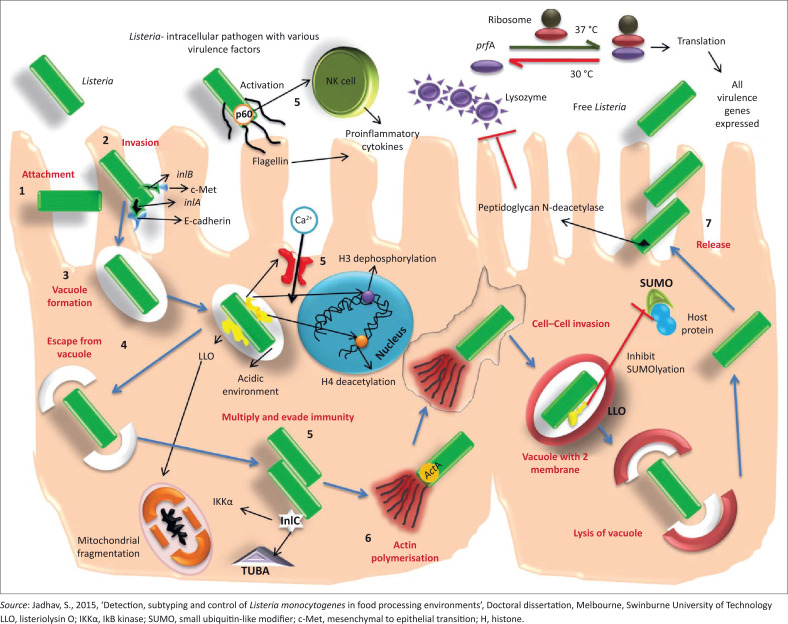A Listeria outbreak initially surfaced in early 2025 across 21 U.S. states, resulting in 38 infections and 12 deaths. The investigation revealed the earliest cases actually date back to 2018, with more than half of all infections occurring in 2024 and 2025. Listeria infections in the U.S. typically peak during the summer months.

Previous Outbreak Investigations of Listeria
Revealing the Authentic Identity of the "Refrigerator Killer"
Listeria species (spp.) are short Gram-positive rods that belong to the phylum Firmicutes, class Bacilli, order Bacillales. The Listeria spp. are facultatively anaerobic, non-spore forming, about 0.5 µm in width and 1 µm – 1.5 µm in length and belong taxonomically to the Clostridium-Bacillus-Lactobacillus sub-branch with Brochothrix thermosphacta. Listeria spp. also have the ability to tolerate salt conditions (NaCl) up to 20% (weight/volume [w/v]) and grows in a pH range of 4.4–9.6. The growth temperature for these species ranges from –0.4 °C to 45 °C, with an optimum growth temperature of 37 °C and can survive at relatively low water activities (aw < 0.90). These growth conditions contribute to their versatility to grow and survive under extreme environmental conditions posed at food-processing facilities and become a serious problem for food industry.
Listeria monocytogenes
Out of the species of Listeria identified thus far, only Listeria monocytogenes can cause infection in both humans and animals. This pathogen has been divided into 13 serotypes (½a, ½b, ½c, 3a, 3b, 3c, 4a, 4ab, 4b, 4c, 4d, 4e, 7) based on somatic and flagellar antigens. These serotypes are further grouped into four genetic diversity lineages (I–IV). These lineages consist of specific serotypes; lineage I harbours serotypes ½b, 3b, 4b, 4d, 4e and 7. Serotypes ½b and 4b within lineage I encode listeriolysin S virulence factor, which is not present in other lineages.
Lineage II contains serotypes ½a, ½c, 3a and 3c and often harbours several plasmids that are resistant to heavy metals. Serotypes 4b, ½a, 4a and 4c belong to lineage III and 4a, 4c and atypical 4b serotypes have been characterised as lineage IV isolates. Listeria monocytogenes is amongst the dangerous bacterial food-borne pathogens in the world, which cause severe human diseases.
During the process of causing foodborne infection in the host, Listeria monocytogenes invades host non-phagocytic cells by leveraging its unique surface proteins. Key factors mediating this invasion include members of the internalin family (such as InlA and InlB) and the P60 protein.

Pathogenesis and virulence genes involved in listeriosis infection in human cells
(Onderstepoort J Vet Res Understepoort J Vet Res. 2020 Oct 9;87(1):1869)
Human listeriosis
Listeriosis is a zoonotic disease that is mainly acquired through consumption of contaminated food by L. monocytogenes. Other possible routes of contamination for humans include direct contact with infected animals and environments.
Uncommon occurrence of listeriosis has also been reported in human beings in the form of endocarditis, hepatitis, myocarditis, arteritis, pneumonia, sinusitis, conjunctivitis, ophthalmitis and joint infections. The incidences of listeriosis are very low in general population, but it remains a major and deadly food-borne disease with hospitalisation rate of over 95%.
This disease occurs in specific segments of the population, which are the elderly, pregnant women, unborn babies and immunocompromised people such as those suffering from acquired immune deficiency syndrome (AIDS) or cancer or those who have undergone organ transplants. Pregnant woman have 17-fold increased risk of contracting invasive listeriosis, and this infection mostly occurs in the third trimester. Listeriosis in pregnant women is generally associated with flu-like symptoms with or without gastrointestinal problem. However, the consequences of foetus or newborn infection are extremely severe, which includes abortion, premature birth, pneumonia and meningitis. Invasive listeriosis is responsible for over 90% of hospitalisation and between 20% and 30% case fatality rate, making it one of the most serious food-borne diseases.
Diagnosis of Listeria monocytogenes
Identification of L. monocytogenes is extremely important for prevention and disease control. The conventional method of isolation of L. monocytogenes includes antibody-based tests, enzyme-linked immunosorbent assay, culture-based methods and immune-capture techniques.
Reference
Matle I, Mbatha KR, Madoroba E. A review of Listeria monocytogenes from meat and meat products: Epidemiology, virulence factors, antimicrobial resistance and diagnosis. Onderstepoort Journal of Veterinary Research. 2020;87(1).
Products List:
|
Catalog |
Product Name |
|
RXX07702 |
Anti-Listeria monocytogenes serotype 1/2a InlB/Internalin B Nanobody (SAA0997) |
|
MXX04202 |
Anti-Listeria monocytogenes serovar 1/2a IAP Monoclonal Antibody (1A180) |
|
RXX07701 |
Anti-Listeria monocytogenes serovar 1/2a InlB/Internalin B Antibody (SAA0363) |
|
YXX04201 |
Recombinant Listeria monocytogenes IAP/p60 Protein, N-His |
More research tools related to Listeria can be found here
